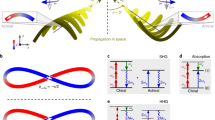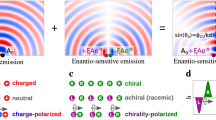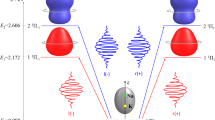Abstract
Chiral interactions are prevalent in nature, driving a variety of biochemical processes. Discerning the two non-superimposable mirror images of a chiral molecule, known as enantiomers, requires interaction with a chiral reagent with known handedness. Circularly polarized light beams are often used as a chiral reagent. Here we demonstrate efficient chiral sensitivity with linearly polarized helical light beams carrying an orbital angular momentum of ±lħ, in which the handedness is defined by the twisted wavefront structure tracing a left- or right-handed corkscrew pattern as it propagates in space. By probing the nonlinear optical response, we show that helicity-dependent nonlinear absorption occurs even in achiral molecules and can be controlled. We model this effect by considering induced multipole moments in light–matter interactions. Design and control of light–matter interactions with helical light may open new opportunities in chiroptical spectroscopy, light-driven molecular machines, optical switching and in situ ultrafast probing of chiral systems and magnetic materials.
This is a preview of subscription content, access via your institution
Access options
Access Nature and 54 other Nature Portfolio journals
Get Nature+, our best-value online-access subscription
$29.99 / 30 days
cancel any time
Subscribe to this journal
Receive 12 print issues and online access
$209.00 per year
only $17.42 per issue
Buy this article
- Purchase on Springer Link
- Instant access to full article PDF
Prices may be subject to local taxes which are calculated during checkout





Similar content being viewed by others
Data availability
The minimum dataset necessary to interpret the results can be obtained from the corresponding authors upon reasonable request.
Code availability
The simulation data were obtained by evaluating the equations using standard technical software. The code is available upon reasonable request to the corresponding authors.
References
Caldwell, D. J. & Eyring, H. The Theory of Optical Activity (Univ. of Utah, 1971).
Nakanishi, K., Berova, N. & Woody, R. Circular Dichroism: Principles and Applications (Wiley, 2000).
Castiglioni, E., Abbate, S. & Longhi, G. Experimental methods for measuring optical rotatory dispersion: survey and outlook. Chirality 23, 711–716 (2011).
Kuball, H.-G. in Encyclopedia of Analytical Science 2nd edn (eds Worsfold, P. et al.) 60–79 (Elsevier, 2005).
Janssen, M. H. M. & Powis, I. Detecting chirality in molecules by imaging photoelectron circular dichroism. Phys. Chem. Chem. Phys. 16, 856–871 (2014).
Tang, Y. & Cohen, A. E. Enhanced enantioselectivity in excitation of chiral molecules by superchiral light. Science 332, 333–336 (2011).
Collins, J. T. et al. Chirality and chiroptical effects in metal nanostructures: fundamental and current trends. Adv. Opt. Matter 5, 1700182 (2017).
Wang, X. & Tang, Z. Circular dichroism studies on plasmonic nanostructures. Small 13, 1601115 (2017).
Cireasa, R. et al. Probing molecular chirality on a sub-femtosecond timescale. Nat. Phys. 11, 654–658 (2015).
Bégin, J.-L., Alsaawy, M. & Bhardwaj, R. Chiral discrimination by recollision enhanced femtosecond laser mass spectrometry. Sci. Rep. 10, 14074 (2020).
Lux, C. et al. Circular dichroism in the photoelectron angular distributions of camphor and fenchone from multiphoton ionization with femtosecond laser pulses. Angew. Chem. Int. Ed. 51, 5001–5005 (2012).
Powis, I. Photoelectron circular dichroism of the randomly oriented chiral molecules glyceraldehyde and lactic acid. J. Chem. Phys. 112, 301 (2000).
Allen, L. et al. Orbital angular momentum of light and the transformation of Laguerre-Gaussian laser modes. Phys. Rev. A 45, 8185–8189 (1992).
Torres, J. P. & Torner, L. Twisted Photons: Applications of Light with Orbital Angular Momentum (Wiley, 2011).
Andrews, D. L. & Babiker, M. The Angular Momentum of Light (Cambridge Univ. Press, 2013).
Surzhykov, A., Seipt, D. & Fritzsche, S. Probing the energy flow in Bessel light beams using atomic photoionization. Phys. Rev. A 94, 033420 (2016).
Wätzel, J. & Berakdar, J. Discerning on a sub-optical-wavelength the attosecond time delays in electron emission from magnetic sublevels by optical vortices. Phys. Rev. A 94, 033414 (2016).
Picón, A. et al. Transferring orbital and spin angular momenta of light to atoms. New J. Phys. 12, 083053 (2010).
Peshkov, A. A., Fritzsche, S. & Surzhykov, A. Ionization of H2+ molecular ions by twisted Bessel light. Phys. Rev. A 92, 043415 (2015).
Franke-Arnold, S., Allen, L. & Padgett, M. Advances in optical angular momentum. Laser Photon. Rev. 2, 299–313 (2008).
Andersen, M. F. et al. Quantized rotation of atoms from photons with orbital angular momentum. Phys. Rev. Lett. 97, 170406 (2006).
He, H. et al. Direct observation of transfer of angular momentum to absorptive particles from a laser beam with a phase singularity. Phys. Rev. Lett. 75, 826–829 (1995).
Schmiegelow, C. T. et al. Transfer of optical orbital angular momentum to a bound electron. Nat. Commun. 7, 129998 (2016).
Picón, A. et al. Photoionization with orbital angular momentum beams. Opt. Express 18, 3660–3671 (2010).
Loffler, W., Broer, D. J. & Woerdman, J. P. Circular dichroism of cholesteric polymers and the orbital angular momentum of light. Phys. Rev. A 83, 065801 (2011).
Araoka, F. et al. Interactions of twisted light with chiral molecules: an experimetal investigation. Phys. Rev. A 71, 055401 (2005).
Andrews, D. L., Romero, L. D. & Babiker, M. On optical vortex interactions with chiral matter. Opt. Commun. 237, 133–139 (2004).
Brullot, W. et al. Resolving enantiomers using the optical angular momentum of twisted light. Sci. Adv. 2, 150134 (2016).
Ni, J. et al. Giant helical dichroism of single chiral nanostructures with photonic orbital angular momentum. ACS Nano 15, 2893–2900 (2021).
Zambrana-Puyalto, X., Vidal, X. & Molina-Terriza, G. Angular momentum-induced circular dichroism in non-chiral nanostructures. Nat. Commun. 5, 4922 (2014).
Forbes, K. A. & Andrews, D. L. Spin–orbit interactions and chiroptical effects engaging orbital angular momentum of twisted light in chiral and achiral media. Phys. Rev. A 99, 023837 (2019).
Forbes, K. A. & Andrews, D. L. Optical orbital angular momentum: twisted light and chirality. Opt. Lett. 43, 435–438 (2018).
Marrucci, L., Manzo, C. & Paparo, D. Optical spin-to-orbital angular momentum conversion in inhomogeneous anisotropic media. Phys. Rev. Lett. 96, 163905 (2006).
Hugo, L. et al. Arbitrary optical wavefront shaping via spin-to-orbit coupling. J. Opt. 18, 124002 (2016).
Temnov, V. V. et al. Multiphoton ionization in dielectrics: comparison of circular and linear polarization. Phys. Rev. Lett. 97, 237403 (2006).
Vivas, M. G. et al. Polarization effect on the two-photon absorption of a chiral compound. Opt. Express 20, 18600–18608 (2012).
Gong, S.-H. & Penzkofer, A. Two-photon absorption and two-photon-induced absorption of some organic liquids at 347.15 nm. Opt. Quantum Electron. 31, 269–290 (1999).
Oosterbeek, R., Ashforth, S., Bodley, O. & Simpson, M. Measuring the ablation threshold fluence in femtosecond laser micromachining with vortex and Bessel pulses. Opt. Express 26, 34558–34568 (2018).
Rahimian, M. G. et al. Spatially controlled nano-structuring of silicon with femtosecond vortex pulses. Sci. Rep. 10, 12643 (2020).
Tang, Y. & Cohen, A. E. Optical chirality and its interaction with matter. Phys. Rev. Lett. 104, 163901 (2010).
Ohkubo, J. et al. Molecular alignment in a liquid induced by a nonresonant laser field: molecular dynamics simulation. J. Chem. Phys. 120, 9123–9132 (2004).
Dooley, P. W. et al. Direct imaging of rotation wave-packet dynamics of diatomic molecules. Phys. Rev. A 68, 023406 (2003).
Fleischer, S. et al. Molecular alignment induced by ultrashort laser pulses and its impact on molecular motion. Is. J. Chem. 52, 414–437 (2012).
Leibscher, M., Averbukh, I. S. & Rabitz, H. Molecular alignment by trains of short laser pulses. Phys. Rev. Lett. 90, 213001 (2003).
Leibscher, M., Averbukh, I. S. & Rabitz, H. Enhanced molecular alignment by short laser pulses. Phys. Rev. A 69, 013402 (2004).
Toro, C. et al. Two-photon absorption circular dichroism: a new twist in nonlinear spectroscopy. Chem. Eur. J. 16, 3504–3509 (2010).
Yang, N. & Cohen, A. E. Local geometry of electromagnetic fields and its role in molecular multipole transitions. J. Phys. Chem. B 115, 5304–5311 (2011).
Barron, L. D. Molecular Light Scattering and Optical Activity (Cambridge Univ. Press, 2004).
Buckingham, A. D. & Dunn, M. B. Optical activity of oriented molecules. J. Chem. Soc. A 1971, 1988–1991 (1971).
Andrews, S. S. Using rotational averaging to calculate the bulk response of isotropic and anisotropic samples from molecular parameters. J. Chem. Educ. 81, 877 (2004).
Andrews, D. L. & Allcock, P. Optical Harmonics in Molecular Systems: Quantum Electrodynamical Theory (Wiley, 2005).
Lipkin, D. Existence of a new conservation law in electromagnetic theory. J. Math. Phys. (N.Y.) 5, 696–700 (1964).
Wang, Z. et al. A novel chiral metasurface with controllable circular dichroism induced by coupling localized and propagating modes. Adv. Opt. Mater. 4, 883–888 (2016).
Guo, Y. et al. Orbital angular momentum dichroism caused by the interaction of electric and magnetic dipole moments and the geometrical asymmetry of chiral metal nanoparticles. Phys. Rev. A 102, 033525 (2020).
Loudon, R. The Quantum Theory of Light (Oxford Univ. Press, 2003).
Forbes, K. A. & Andrews, D. L. Orbital angular momentum of twisted light: chirality and optical activity. J. Phys. Photon. 3, 022007 (2021).
Bradshaw, D. S. & Andrews, D. L. Manipulating particles with light: radiation and gradient forces. Eur. J. Phys. 38, 034008 (2017).
Cerjan, A. et al. Orbital angular momentum of Laguerre-Gaussian beams beyond the paraxial approximation. J. Opt. Soc. Am. A 28, 2253–2260 (2011).
Forbes, K. A. et al. Relevance of longitudinal fields of paraxial optical vortices. J. Opt. 23, 075401 (2021).
Acknowledgements
We acknowledge financial support from the Natural Science and Engineering Council of Canada, Canada Research Chairs and Canadian Foundation for Innovation.
Author information
Authors and Affiliations
Contributions
J-L.B., A.J. and R.B. conceived the experiments. J-L.B., A.J. and R.B. designed and planned the experiments. J-L.B. and A.J. conducted the experiments and analysed the results. J-L.B., A.J., A.P., T.B. and R.B. worked on the theory and conducted numerical simulations. F.H. fabricated the q-plates, P.C., E.K. and R.B. supervised the project. J-L.B., A.J., T.B. and R.B. prepared the first draft, and all authors reviewed the manuscript.
Corresponding author
Ethics declarations
Competing interests
The authors declare no competing interests.
Peer review
Peer review information
Nature Photonics thanks David Andrews and the other, anonymous, reviewer(s) for their contribution to the peer review of this work.
Additional information
Publisher’s note Springer Nature remains neutral with regard to jurisdictional claims in published maps and institutional affiliations.
Supplementary information
Supplementary Information
Supplementary Information, including ten sections. Additional results are provided in sections 1 to 7, including Figs. 1–8. The Discussion includes three sections: fluence calculations with Fig. 9, optical force dipole with Fig. 10 and the theory on extension to multiphotons.
Rights and permissions
Springer Nature or its licensor (e.g. a society or other partner) holds exclusive rights to this article under a publishing agreement with the author(s) or other rightsholder(s); author self-archiving of the accepted manuscript version of this article is solely governed by the terms of such publishing agreement and applicable law.
About this article
Cite this article
Bégin, JL., Jain, A., Parks, A. et al. Nonlinear helical dichroism in chiral and achiral molecules. Nat. Photon. 17, 82–88 (2023). https://doi.org/10.1038/s41566-022-01100-0
Received:
Accepted:
Published:
Issue Date:
DOI: https://doi.org/10.1038/s41566-022-01100-0
This article is cited by
-
Intrinsic dichroism in amorphous and crystalline solids with helical light
Nature Communications (2024)
-
Metafiber transforming arbitrarily structured light
Nature Communications (2023)
-
Time-resolved plasmon-assisted generation of optical-vortex pulses
Scientific Reports (2023)



